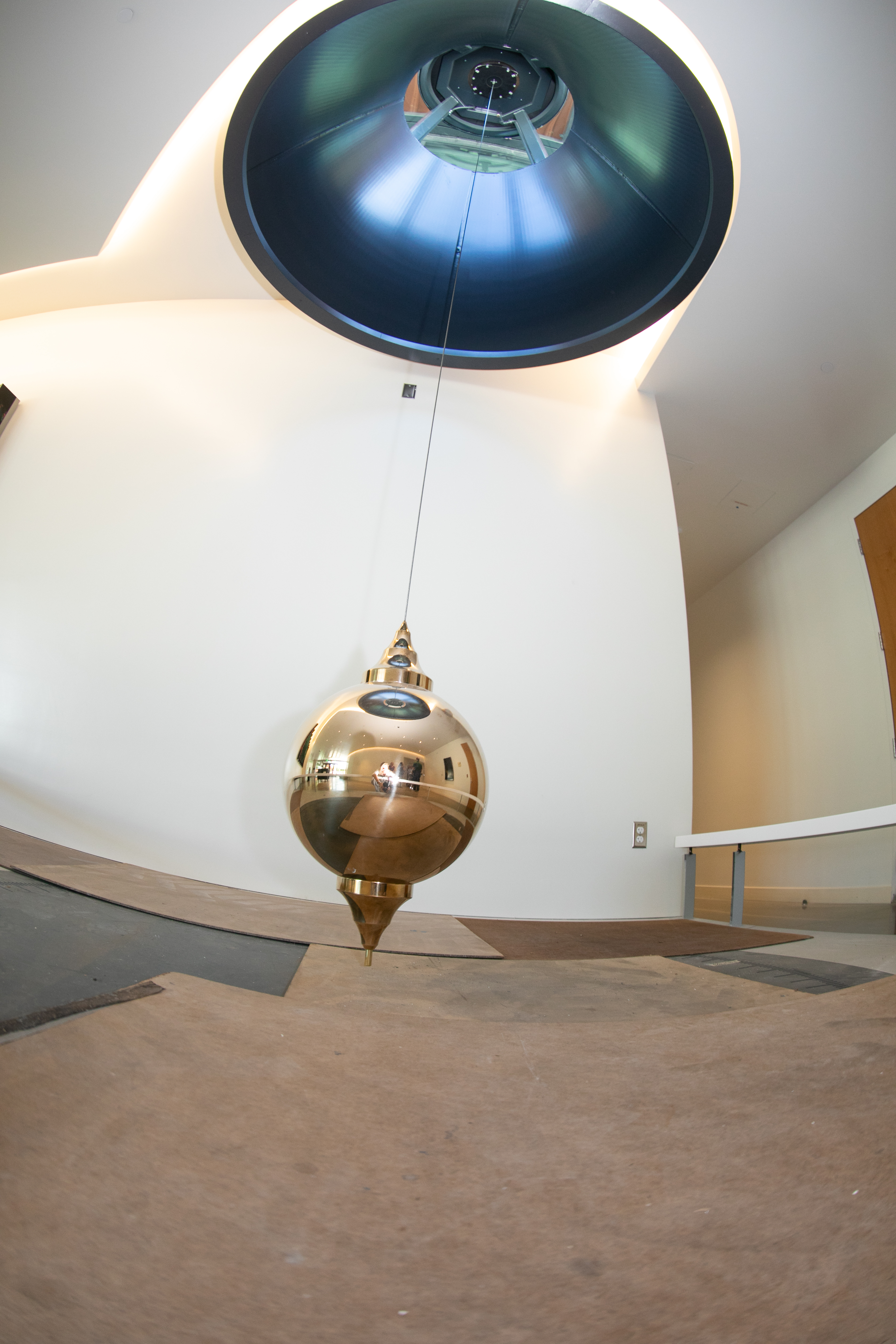 The University's Foucault pendulum gently swings along its ever-moving path in the first-floor lobby of the Ernest E. Tschannen Science Complex. (Sacramento State/Andrea Price)
The University's Foucault pendulum gently swings along its ever-moving path in the first-floor lobby of the Ernest E. Tschannen Science Complex. (Sacramento State/Andrea Price)By Dixie Reid
The gently moving jewel swaying inside the new Ernest E. Tschannen Science Complex is a Foucault pendulum – shiny and slow-swinging, it is a piece of old-world technology the likes of which have kept track of the earth's rotation for the last 168 years.
It’s a singular attraction in University's state-of-the-art Science Complex, which will experience the public spotlight during grand-opening ceremonies on Wednesday, Sept. 18.
The event begins at 11 a.m. in front of the complex, on the east side of campus near the American River.
The pendulum is a 235-pound polished-brass "bob," resembling a Christmas ornament, suspended by cable affixed to a pivot point high above. It was bequeathed to the University by a former Sacramento State physics professor.
The pendulum was in storage for several years before finding its home in the first-floor Science Complex lobby, where it hangs over a flat plate marked with compass points. It is positioned near the entrance to the Sacramento State planetarium, an already-popular feature of the new facility.
The pendulum revolves a full 360 degrees, in the opposite direction of the Earth’s west-to-east movement.
“The Foucault pendulum was the first-ever direct evidence that the Earth spins on its axis,” said Chris Taylor, professor and chair of the Department of Physics & Astronomy. “People were pretty sure for hundreds of years that the Earth was spinning but couldn’t prove it, because it looked like the sky was moving around them.”
In 1851, French scientist Léon Foucault published findings of his revolutionary pendulum experiment, ending 200 years of attempts to demonstrate the planet’s movement.
“The pendulum swings back and forth and looks like it’s changing direction, but it’s the Earth spinning,” Taylor said. “The plate below is marked north, south, east, and west. If you come back in a couple of hours, you can see how far the pendulum has moved since the last time you saw it.”
Chien Yuan Hu, born in China and educated in Taiwan and the University of Missouri, retired from Sacramento State in 1992, after 26 years as a professor of physics. He died in December 2001, bequeathing his nearly $2 million estate to the University. The Chien Hu Physics Endowment funds an annual scholarship for outstanding physics majors.
Hu had stipulated that endowment income be used to purchase a Foucault pendulum to hang in Sac State’s new science building, whenever it was built.
“We bought the pendulum from the California Academy of Sciences 10 or 15 years ago,” Taylor said. “It’s been sitting in storage, waiting for us to have a place to put it.
“Professor Hu was interested in the history and philosophy of science. It’s pretty obvious now, especially after sending astronauts into space, that the Earth is spinning, but in the 1800s and before, how would you know?”
Magnets power the pendulum’s motor, which is housed in what resembles a glass-sided space capsule on the second-level roof terrace, and the pendulum is suspended below.
It hangs in relatively open space, unencumbered by any partitions, positioning that has enticed some people to reach out and touch it – to ill effect. Touching the bob leaves marks on its shiny surface and, more significantly, interrupts its swing path.
“We hope that no one touches the pendulum and gets fingerprints all over it,” Taylor said. “If it’s knocked out of adjustment, we have to stop it for about a half-hour and restart it.”
All while the Earth keeps on spinning.
EDITOR'S NOTE: Because of an editing error, an earlier version of this story incorrectly specified how long it takes for the pendulum to complete a 360 degree path. The time of that movement varies.
